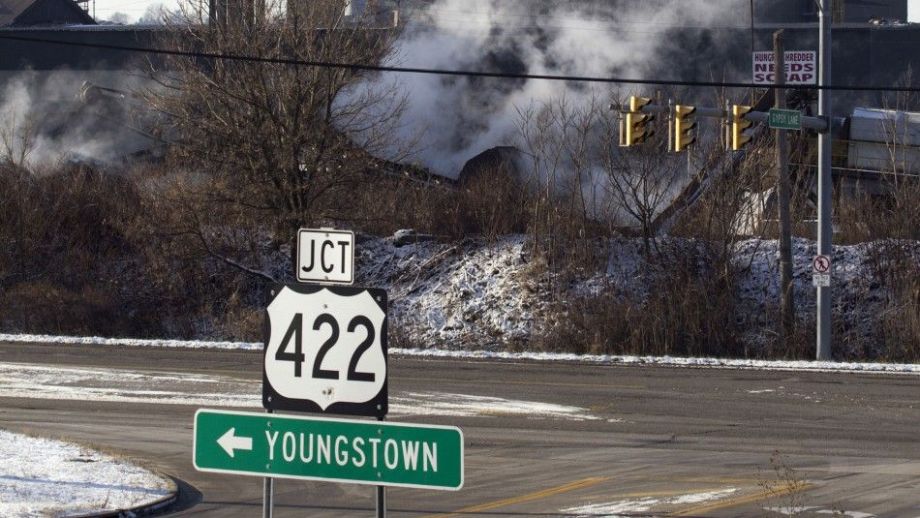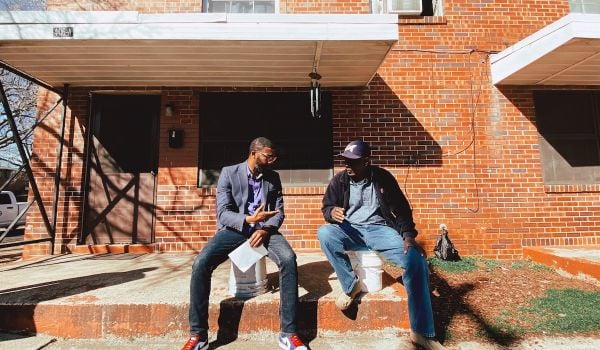The issue of hydraulic fracturing has sparked debates across the U.S., usually pitting those opposed to the practice’s environmental implications against those who see it as a major job creator. But the debate has touched the city of Youngstown, Ohio literally, given that at least 11 recent earthquakes in the region have been traced back to injection wells — only one way fracking companies dispose of their waste. And yet, with one factory expanding specifically to accommodate demand for pipes used in fracking, the potential economic benefit for this struggling industrial city can’t be ignored.
In Forefront this week, Sarah Goodyear talks with city leaders, activists and local boosters to find out if all the digging is worth it.
Mike Ray saw the flashing lights of work trucks parked on the road not far from his house, but he didn’t think much of it that snowy day in early February. The Youngstown city councilmember lives near V&M Star, a steel mill that’s been expanding recently, making pipes for the booming hydraulic fracturing industry. The trucks, he figured, must be related to the construction.
The mill is a rare bright spot in this Ohio city where heavy industry paid the bills for generations but collapsed in the 1970s, leaving behind a town starved of jobs and fading fast. Youngstown’s population has declined 60 percent since 1950. Its neighborhoods are populated by ghostly abandoned homes, its shopping districts shuttered for business, its violent crime rate stubbornly high.
Only several days later did Ray realize what the trucks had actually been doing: Cleaning up the residue from what might amount to hundreds of thousands of gallons of illegally dumped wastewater derived from the process of hydraulic fracturing, or fracking.
State officials said that the waste, containing unknown toxins, had been discharged intentionally into a storm sewer on Youngstown’s Salt Springs Road. The sewer drains into a tributary of the Mahoning River, a waterway in the Ohio River watershed that is already much insulted by industrial waste pumped into it over the years.
The alleged culprit? A company called Hard Rock Excavating, with headquarters on Salt Springs Road. The Ohio Department of Natural Resources (ODNR) charged that Ben Lupo, CEO of D&L Energy, the company that owns Hard Rock, had ordered the discharge of “brine residue material.” D&L itself had already racked up at least 120 violations at 32 drilling sites in Ohio, according to the Youngstown Vindicator, and the company’s permits to operate were permanently revoked in the days after the dumping. The United States Attorney has charged Lupo with one count of violating the U.S. Clean Water Act.
Ray, 36, wears a bowtie and glasses with a nerdy panache. A son of Youngstown’s West Side with an ingrained respect for the city’s gritty past, he went to Youngstown State University, even serving as the school’s penguin mascot, and knows all about his hometown’s old ways. But he is also a member of a generation that has seen the damaging effects of pollution and corruption firsthand and doesn’t want to put up with it any longer. “They dump stuff in the river, we should go after them,” he said. “This raises the attention for tighter regulation. This happened right under our noses. What they were doing is hiding in plain sight.”
The incident was just the latest twist in the story of Youngstown’s complicated relationship with the nation’s fracking boom. For many city residents, it took an earthquake to get them to pay attention to the burgeoning local industry.
The quakes started small, around 2.0 on the Richter scale, in March 2011. But they were frequent and unusual enough to attract media attention; the area had never before experienced such seismic activity. Observers noted their proximity to an injection well that had been used as a burial ground for the millions of gallons of water, sand and chemicals left over from the hydrofracking process.
By Christmas Eve of 2011, when a 2.7 quake hit — the tenth since March — the level of concern had risen significantly. D&L, the same company responsible for the illegal dumping, halted injection on December 30. Less than 24 hours later, the city experienced a 4.0 quake. It jolted Youngstown Mayor Charles Sammarone in his home, not far from the drilling site.
“There was a loud noise,” said Sammarone, a voluble white-haired man who has worked in city government for 30 years. “I thought someone pulled in my drive and hit the garage door. When the noise stopped, the house started shaking. I thought, ‘we better go outside.’”
The state put a temporary moratorium on injection wells after the New Year’s Eve quake, and subsequently determined that the D&L well had, in fact, been the source of the seismic activity. Ohio Gov. John Kasich signed an executive order tightening regulations on injection wells, and while the state has now resumed permitting the process, a seven-mile area around the D&L well remains off limits.
The limitation is one of few imposed on the industry’s growth. Boosters say that’s a good thing, especially for Youngstown.
To these advocates, the nascent boom, injection wells and all, is the weakened city’s only hope for economic salvation. Theirs, however, is not a view shared by everyone. To others, fracking is a powerful threat to the city’s very existence, a threat that has already proven its ability to disrupt the area’s ecosystem.
In an interview this fall, Sammarone shrugged off the concerns as a matter of politics. Though he said the industry must be regulated to prevent future earthquakes and other environmental violations, the mayor also said that fracking presents an economic opportunity the city can’t afford to ignore, and that the opposition represents a minority of public opinion.
“There’s always somebody that’s against something,” he said.
Last fall, the conundrum became inescapable when the Youngstown City Council voted 5-2 to support opening up 180 acres of city-owned land for fracking. The idea was that fracking revenue could finance the demolition of some of the thousands of empty homes that blot city streets. It was a dismal calculus: The city would pay to tear down homes built during the last industrial bonanza, which left behind polluted rivers and soil, with money from a 21st-century fossil fuel boom that has a similar potential for environmental harm. By authorizing officials to seek bids on mineral rights, the mayor and the council forced a conversation that was just as much about Youngstown’s future as it was its past.
Ray was one of the two dissenters on the council, saying he wanted the legislative body to play a larger role in the process. He thought the council should review all requests for proposals and have an opportunity to influence the conditions required for drilling. The idea didn’t get the support it needed to be written into the policy. Despite the council vote, no proposals have yet gone out to bid, although the possibility remains on the table.
Youngstown, which has a long and not-always-proud history of embodying American socioeconomic trends, finds itself at the intersection of two national conundrums: Urban decline, meet fracking.
To read more, subscribe to Forefront. Already a subscriber? Click here to continue reading.









